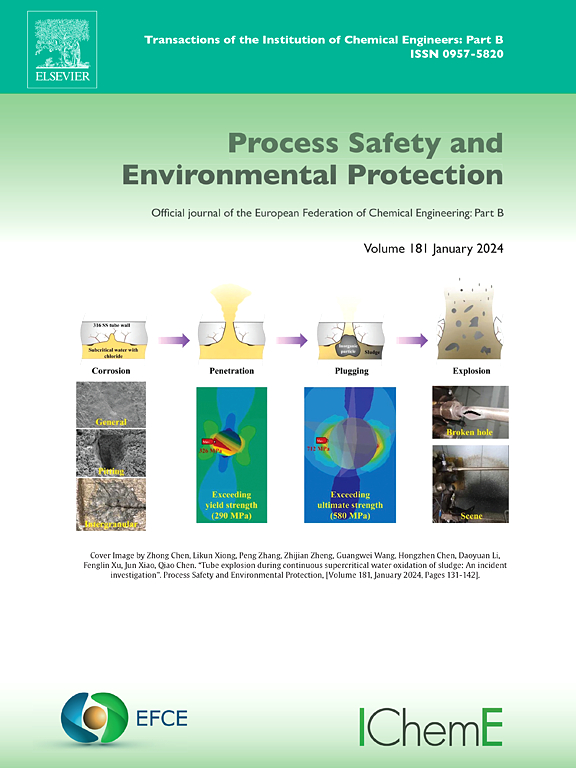电石工业余热回收中能源互补厂内/厂间集成热交换器网络的优化改造
IF 6.9
2区 环境科学与生态学
Q1 ENGINEERING, CHEMICAL
引用次数: 0
摘要
电石行业以其能源和排放强度为特征,在“双碳”时代面临着紧迫的可持续发展需求。这项研究确定了热交换网络中的大量节能机会。提出了一种结合厂内/厂间热集成的优化方法来改造碳化物厂换热网络,以提高能源效率。这种方法主要基于夹紧技术,首先在子系统内重建热交换,以最大限度地减少效用消耗。结果表明,分系统1和分系统2的厂内热集成节能分别为31.49 %和28.79 %。随后,从优化后的子系统中提取多余的热量和冷负荷作为新的换热流,促进子系统之间的换热匹配。因此,分系统1的余热作为热源,分系统2的余冷作为厂间集成的散热器,形成协同节能机制,实现厂间热集成。厂间热集成的总能量达到10.83 MW,总热回收潜力为38.55 MW,最终实现了显着的总节能率,同时最大限度地减少了换热装置。该研究强调了多能互补对提高未来碳化物工业能源效率的重要性。本文章由计算机程序翻译,如有差异,请以英文原文为准。
Optimization and renovation of energy complementary intra-plant/inter-plant integrated heat exchanger networks for waste heat recovery in the calcium carbide industry
The calcium carbide industry, characterized by its energy and emissions intensity, faces pressing sustainability demands in the “double-carbon” era. This study identifies substantial energy-saving opportunities within heat exchange networks. An optimization method is proposed that combines intra-/inter-plant heat integration to retrofit carbide plant heat exchange networks for energy efficiency. This approach is primarily based on pinch technology, where the heat exchange was first reconstructed within subsystems to minimize utility consumption. Results indicate that the intra-plant heat integration yields energy savings of 31.49 % for subsystem 1 and 28.79 % for subsystem 2. Subsequently, excess heat and cooling loads from the optimized subsystems were extracted as new heat exchange streams, facilitating heat exchange matching between subsystems. Thus, excess heat from subsystem 1 serves as heat source, while the excess cold from subsystem 2 acts as heat sink in inter-plant integration, creating a synergistic energy-saving mechanism to achieve inter-plant heat integration. The total energy from inter-plant heat integration reaches 10.83 MW, contributing to an overall heat recovery potential of 38.55 MW, ultimately achieving a remarkable total energy saving rate while minimizing the heat exchange units in this case. This research underscores the importance of multi-energy complementarity in advancing energy efficiency for future carbide industry.
求助全文
通过发布文献求助,成功后即可免费获取论文全文。
去求助
来源期刊

Process Safety and Environmental Protection
环境科学-工程:化工
CiteScore
11.40
自引率
15.40%
发文量
929
审稿时长
8.0 months
期刊介绍:
The Process Safety and Environmental Protection (PSEP) journal is a leading international publication that focuses on the publication of high-quality, original research papers in the field of engineering, specifically those related to the safety of industrial processes and environmental protection. The journal encourages submissions that present new developments in safety and environmental aspects, particularly those that show how research findings can be applied in process engineering design and practice.
PSEP is particularly interested in research that brings fresh perspectives to established engineering principles, identifies unsolved problems, or suggests directions for future research. The journal also values contributions that push the boundaries of traditional engineering and welcomes multidisciplinary papers.
PSEP's articles are abstracted and indexed by a range of databases and services, which helps to ensure that the journal's research is accessible and recognized in the academic and professional communities. These databases include ANTE, Chemical Abstracts, Chemical Hazards in Industry, Current Contents, Elsevier Engineering Information database, Pascal Francis, Web of Science, Scopus, Engineering Information Database EnCompass LIT (Elsevier), and INSPEC. This wide coverage facilitates the dissemination of the journal's content to a global audience interested in process safety and environmental engineering.
 求助内容:
求助内容: 应助结果提醒方式:
应助结果提醒方式:


